Not everything rose. Prices fell for new vehicles, auto parts, auto accessories, and phones.
By Wolf Richter for WOLF STREET.
The PCE price index – favored by the Fed as yardstick for its inflation target and usually lower than the CPI (released earlier in July) – broadly accelerated month-to-month in June, including in services, where the majority of consumer spending goes.
In terms of the tariffs: Whether or not companies can pass them on depends on market conditions – whether consumers keep buying products at higher prices, now that the free money is gone, or whether sales fall, and companies have to cut prices to get the sales they want. We’re seeing some of both.
Durable goods are heavily exposed to tariffs since a lot of them are imported, or their components are imported. Durable goods inflation had dropped to 0% in May from April, and in June bounced back up, but was below April. Month to month:
- Prices fell in some categories (negative inflation): new vehicles, auto accessories, auto parts, phones, etc.
- Prices rose in other categories: tires, furniture, appliances, sporting equipment, video and audio equipment, etc.
Month-to-month changes, going back a few months:
- Overall PCE price index:
- June: +0.28%
- May: +0.17%
- April: +0.16%
- Core PCE price index:
- June: +0.26%
- May: +0.21%
- April: +0.18%.
- Core-services PCE price index:
- June: +0.21%
- May: +0.20%
- April: +0.14%.
- Durable goods, ratcheting out of the deeply negative readings since early 2024.
- June: +0.47%
- May: 0.0%
- April: +0.49%
- March: -0.05%
- February: +0.41%….
- Energy spiked, reversing the plunge in the prior month:
- June: +0.92%
- May: -0.97%
- April: +0.54%.
- Food purchased at stores:
- June: +0.26%
- May: +0.17%
- April: -0.28%.
On a year-over-year basis in June:
The overall PCE price index (+2.6%, red in the chart) and the core PCE price index (+2.8%, blue in the chart) accelerated and moved further away from the Fed’s 2% target.
The core services PCE index, at +3.4% (yellow) for the third month in a row, is substantially hotter than in the pre-pandemic years and the biggie that keeps core PCE and overall PCE well above the Fed’s target.
The durable goods PCE price index (+0.9%, dotted green) has been becoming less negative and then more positive since early 2024, after the deep plunge off the historic spike.
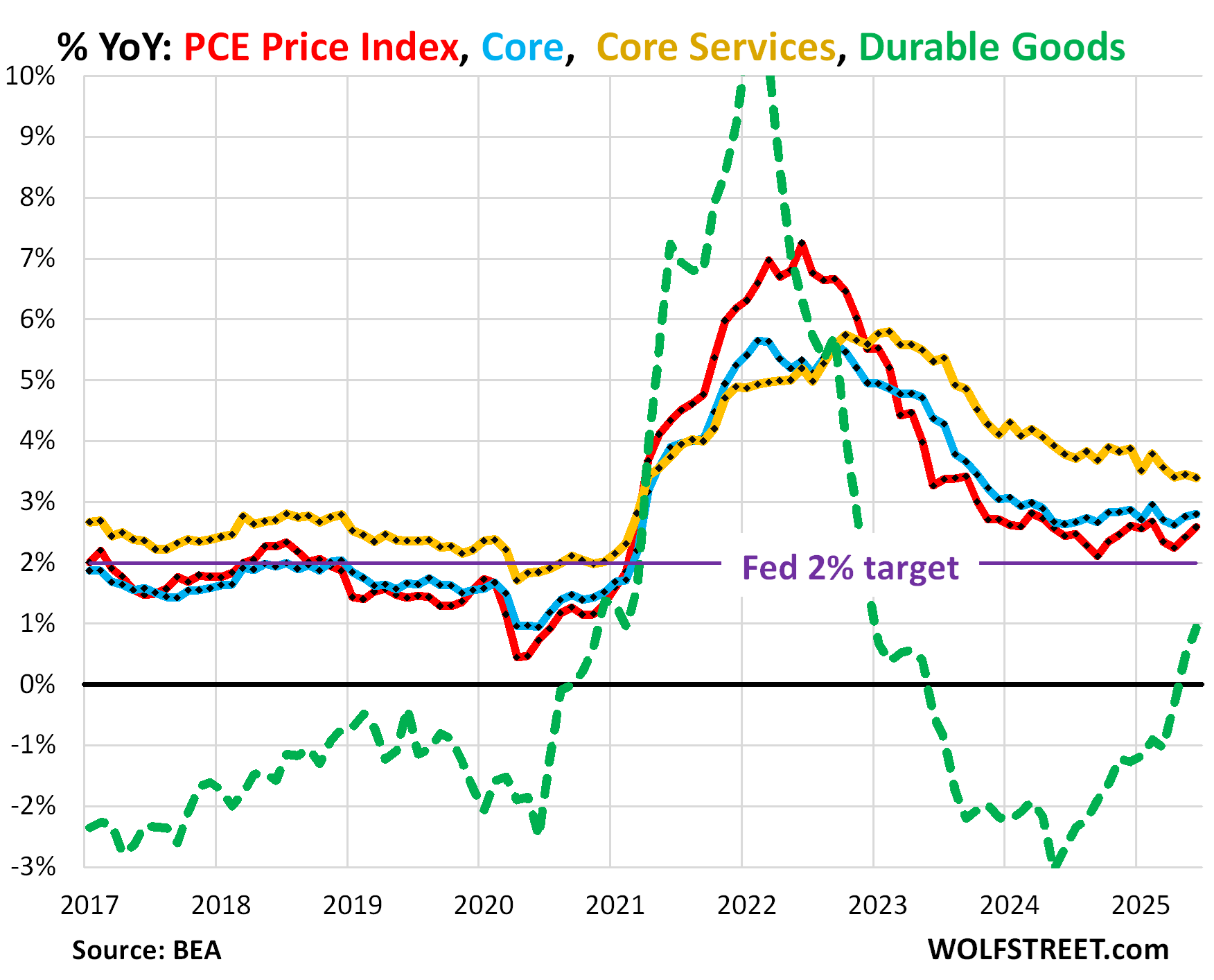
Month-over-month and on a 6-month basis:
The overall PCE price index accelerated to + 0.28% (+3.4% annualized) in June from May, as services inflation accelerated, durable goods inflation accelerated, food inflation accelerated, and energy prices spiked back after the plunge in the prior month.
The 6-month PCE price index, which irons out the month-to-month squiggles, rose by 2.9% annualized, same as in May, and up a tad from April, but still lower than in February. It had bottomed out in September and October last year and then headed higher.
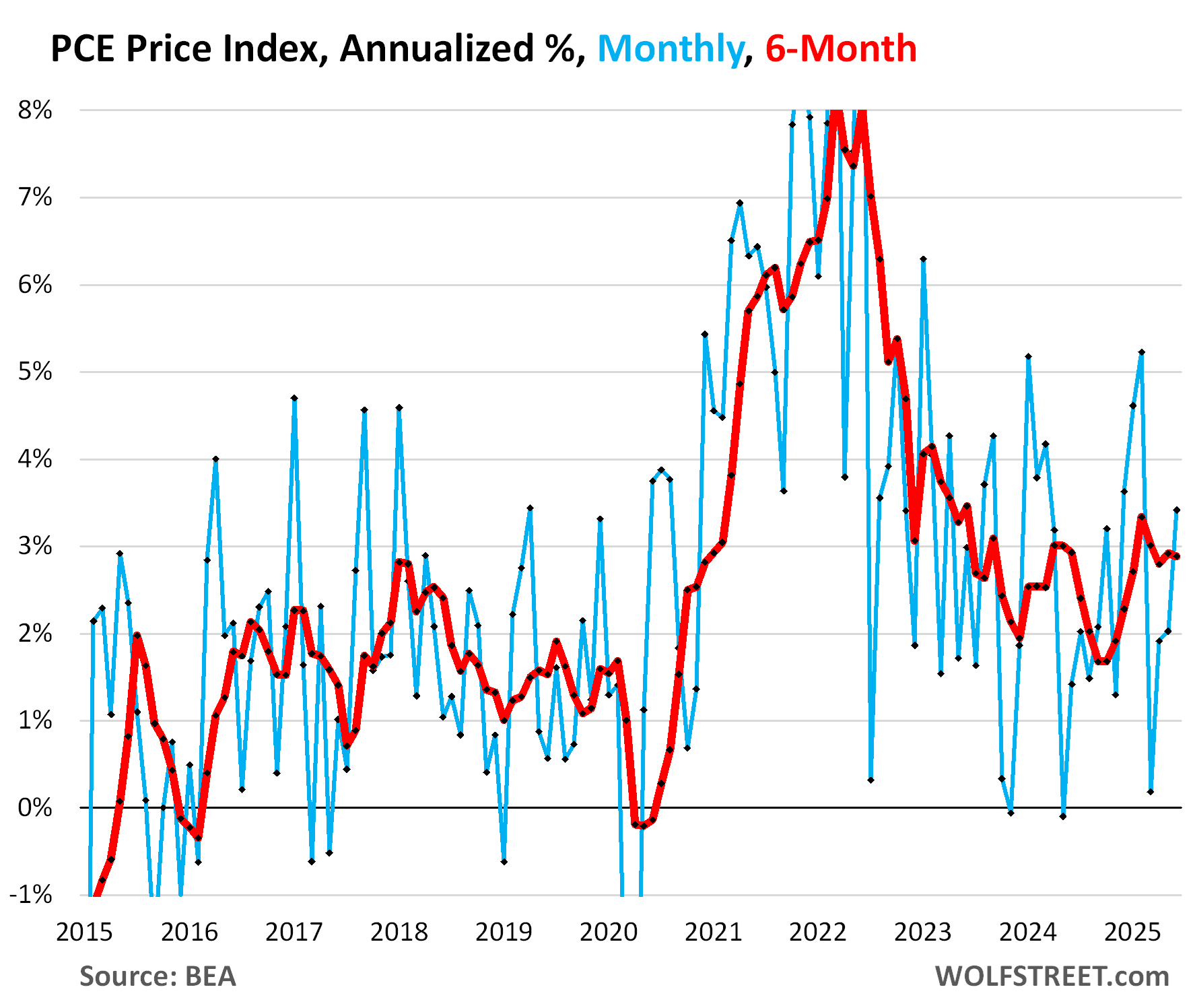
The core PCE price index, which excludes food and energy items, accelerated to +0.26% (+3.1% annualized).
The 6-month core PCE price index (red) accelerated to +3.2% annualized.
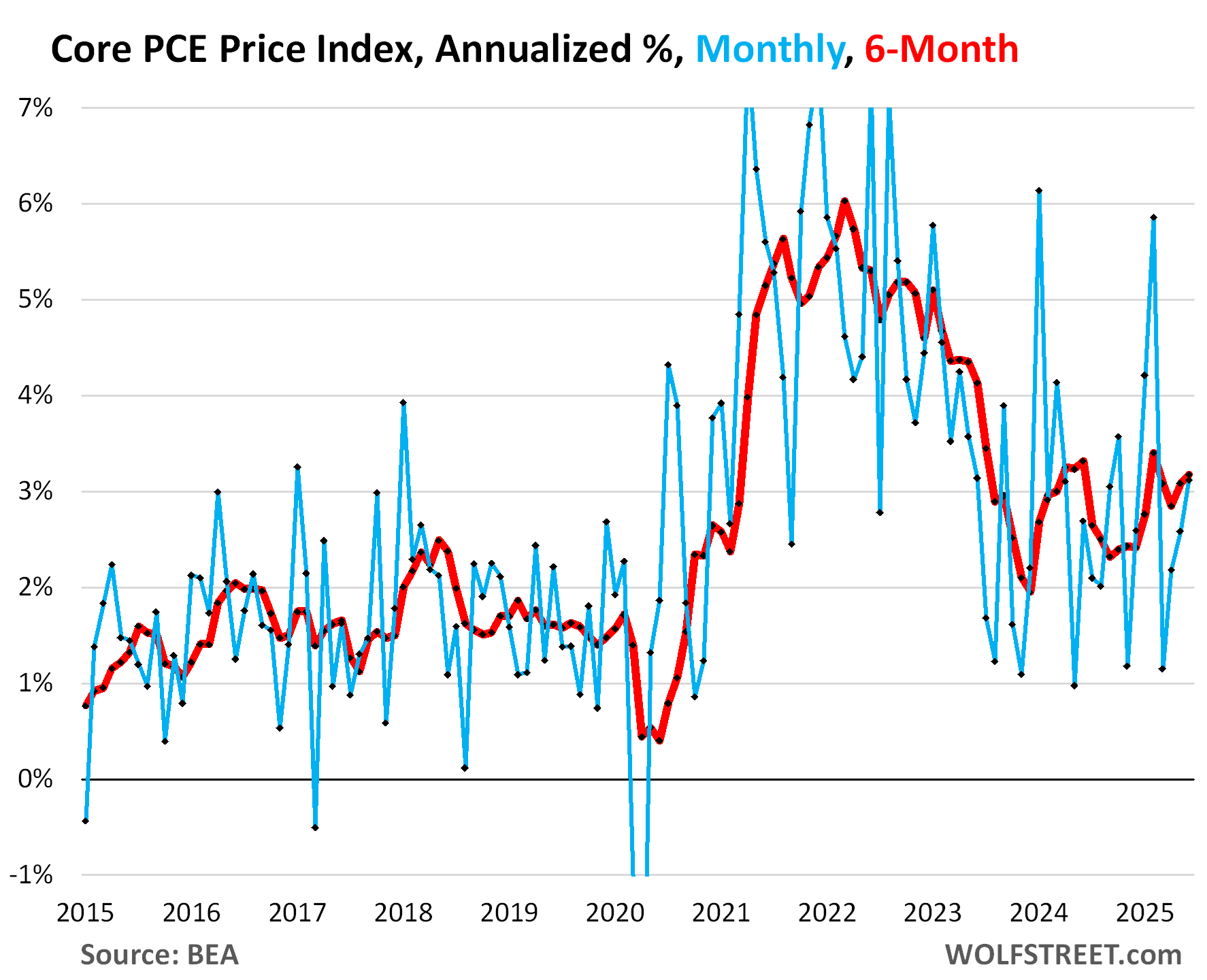
The core services PCE Price Index, which excludes energy services, accelerated to +0.21 (+2.6% annualized), and the prior two months were revised higher.
May was revised higher to +0.21% from the originally reported +0.16%. And April was revised higher to +0.14% from +0.09%.
These up-revisions caused the 6-month index for May to be revised higher today to +3.6% annualized from 3.4% as reported a month ago.
For June, the 6-month core services PCE price index decelerated from the upwardly revised May to +3.2%.
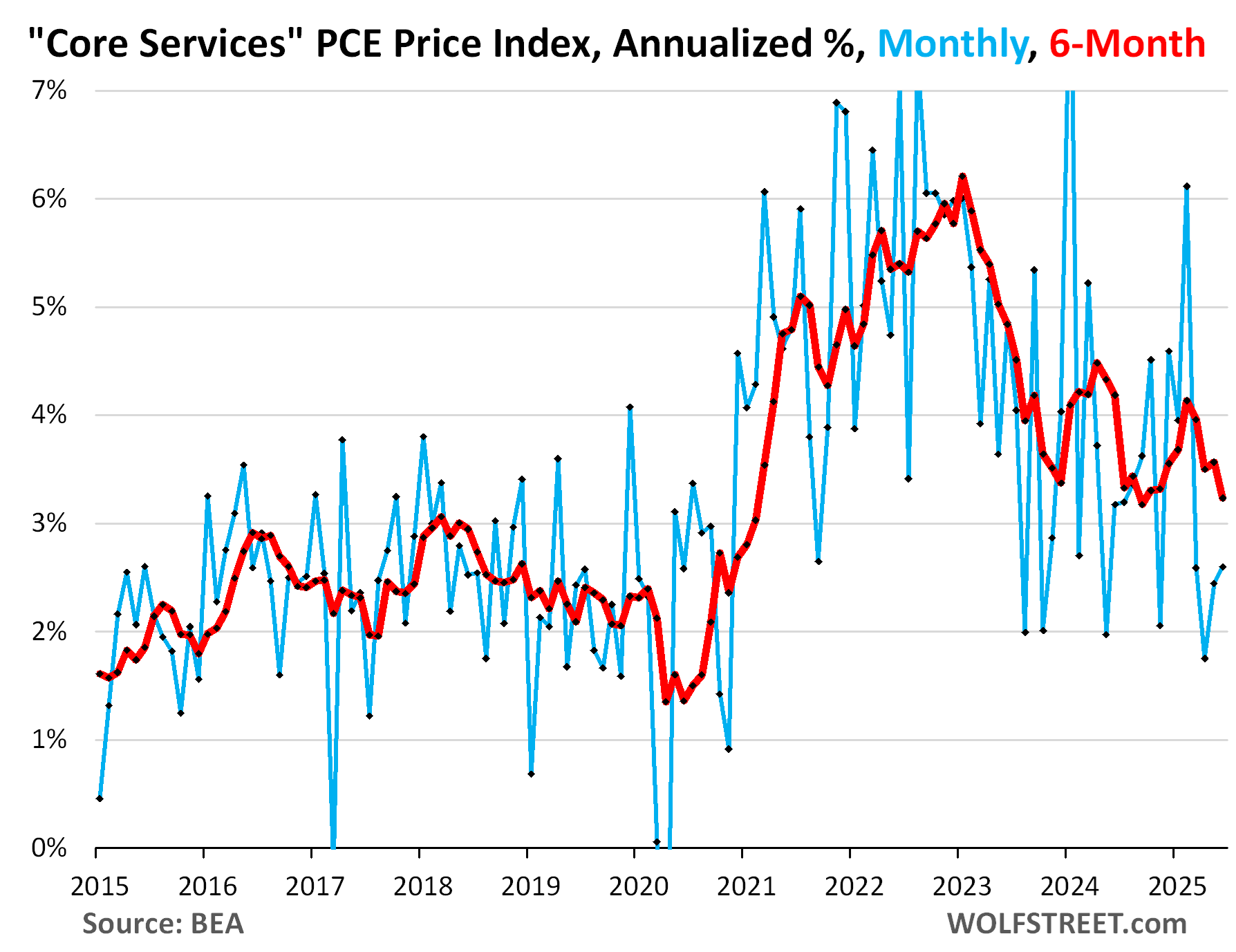
Housing inflation has stabilized near 4%. The PCE price index for housing, based on various rent factors, rose by 0.28% (3.5% annualized) in June from May. It has squiggled up and down for 10 months between 3% and 5%.
The 6-month housing index (red) remained at +3.8% annualized, for the fifth month in a row in that range.
The year-over-year index remained at +4.1% (yellow).
Housing is a big part of the core services PCE price index, and it has cooled from the red-hot levels, with the six-month index stabilizing near 4%. Even before the pandemic, the six-month index and the year-over-year index ranged between 3% and 4%, roughly double the overall and core PCE price indices at the time, and a major driver of inflation. And it continues to be that.
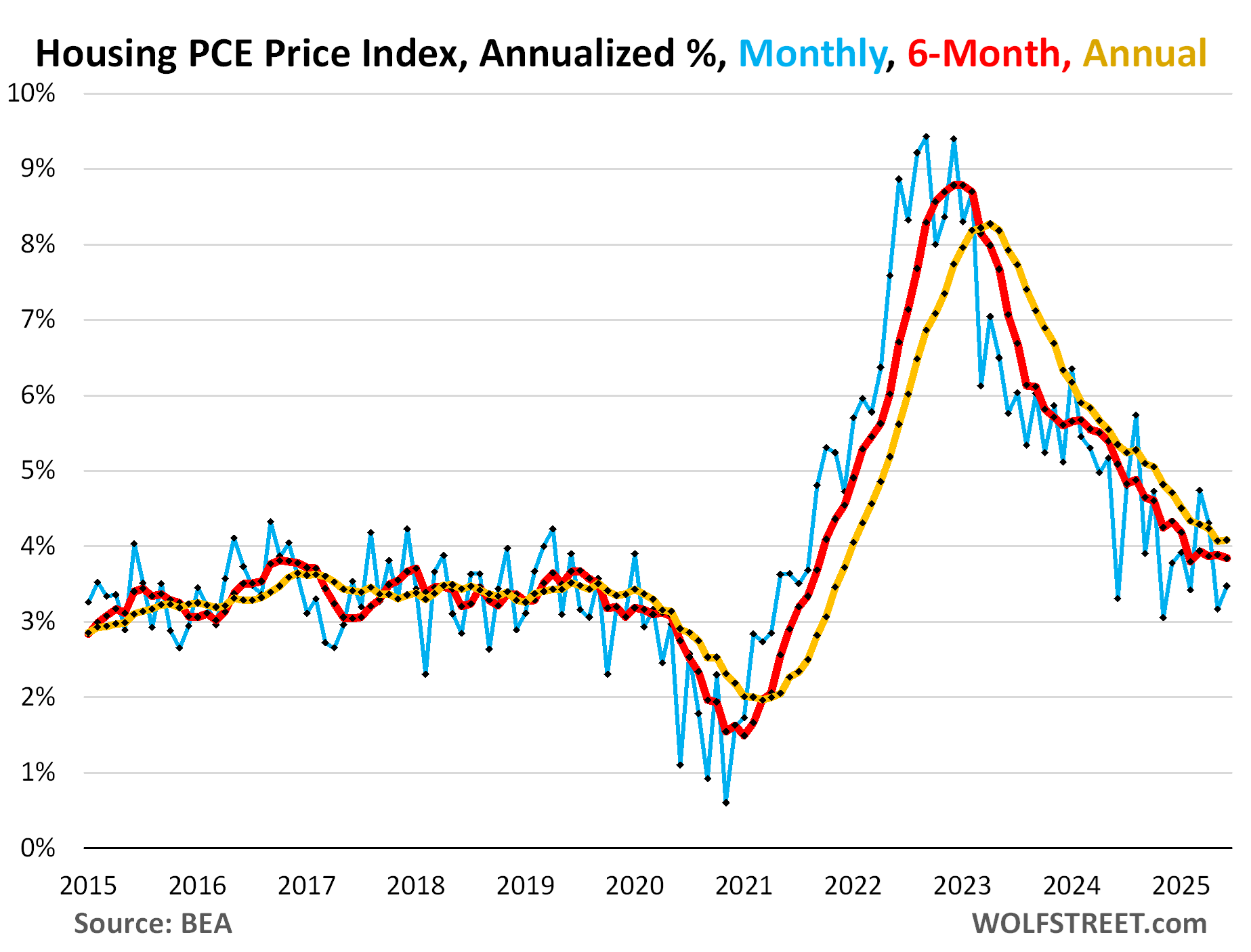
Durable goods prices zigzagging out of the hole since early 2024. Durable goods include motor vehicles, appliances, furniture, bicycles, motorcycles, phones, audio and video equipment, etc. Many of these products or their components and materials are produced overseas and are subjected to tariffs.
On a month-to-month basis, the index jumps up and down a lot. In June, it jumped by 0.47% after the 0% change in May. April was +0.49%. March was negative -0.05%.
It has been zigzagging higher for over a year since the low point in early 2024. In 2021 and 2022, it went through a historically ferocious spike, fueled by free-money policies. That price spike partially unwound by early 2024.
The six-month PCE price index for durable goods accelerated to +3.3% annualized. It had bottomed out in December 2023 at -4.3% annualized.
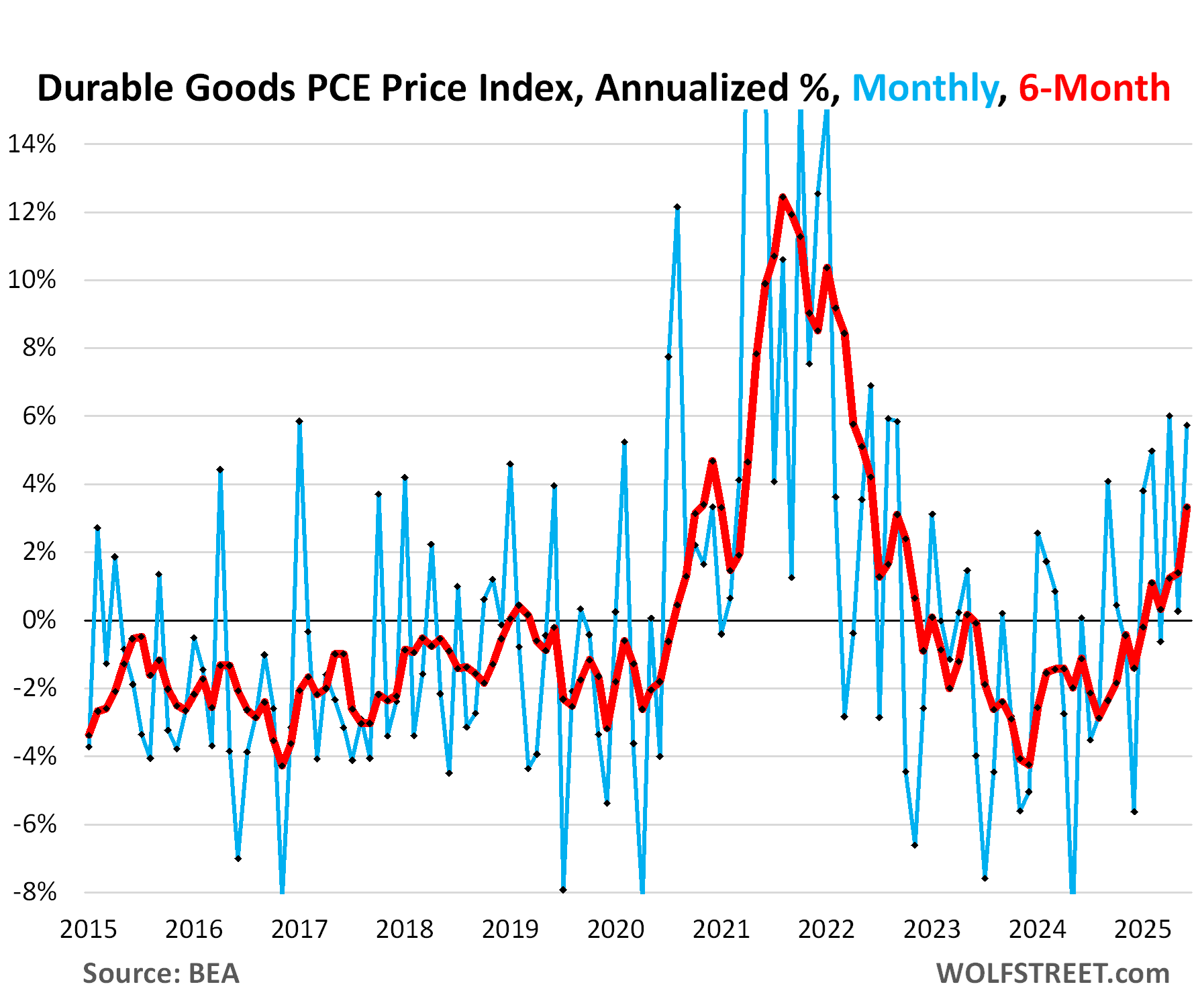
This is what the Fed is waiting for.
All companies want to raise prices all the time. The reason they don’t is that sales plunge when they do. But in 2021 and 2022, they saw that they could jack up prices and sales didn’t plunge because consumers were willing to pay whatever, as free money rained down upon them, and prices don’t matter when money is free. So companies jacked up prices, and their profits exploded in a historic manner. See chart below.
But by mid-2022, consumers had had it with these price increases, and started shopping around again, looking for deals, or not buying at all. And companies had to respond by cutting prices and offering deals. This happened in many categories, and durable goods prices dropped sharply.
But the price cutting faded in early 2024 when consumers began tolerating some price increases again, and this trend has continued.
Whether or not companies can pass on the tariffs depends on market conditions – for retailers, it depends on consumers.
Automakers found out that they cannot pass on the tariffs because sales are already struggling, and they have to cut prices and offer deals to get the sales. And they have announced in their quarterly reports and earnings warnings just how much the tariffs are costing them, including GM which imports vehicles from Mexico, South Korea, China, and Canada. And they’re now shifting more production to the US. But it takes time.
Some retailers have recently raised prices on some of their products, and some got away with it, and some didn’t and got hit by sales declines.
Powell spelled that out yesterday at the press conference, including that companies are having a hard time passing on price increases because consumers are resisting them, but that prices have risen on some goods.
So they will wait and see to what extent tariffs make it into consumer prices. Whatever part of the tariffs makes it into consumer prices might just a one-time bump in the price level. But they’re worried that price increases might continue and spread as general inflation not related to tariffs.
But don’t cry for the companies that can’t pass on the tariffs: During the high-inflation years, they jacked up prices and their profits exploded, which is where a big part of the inflation went:
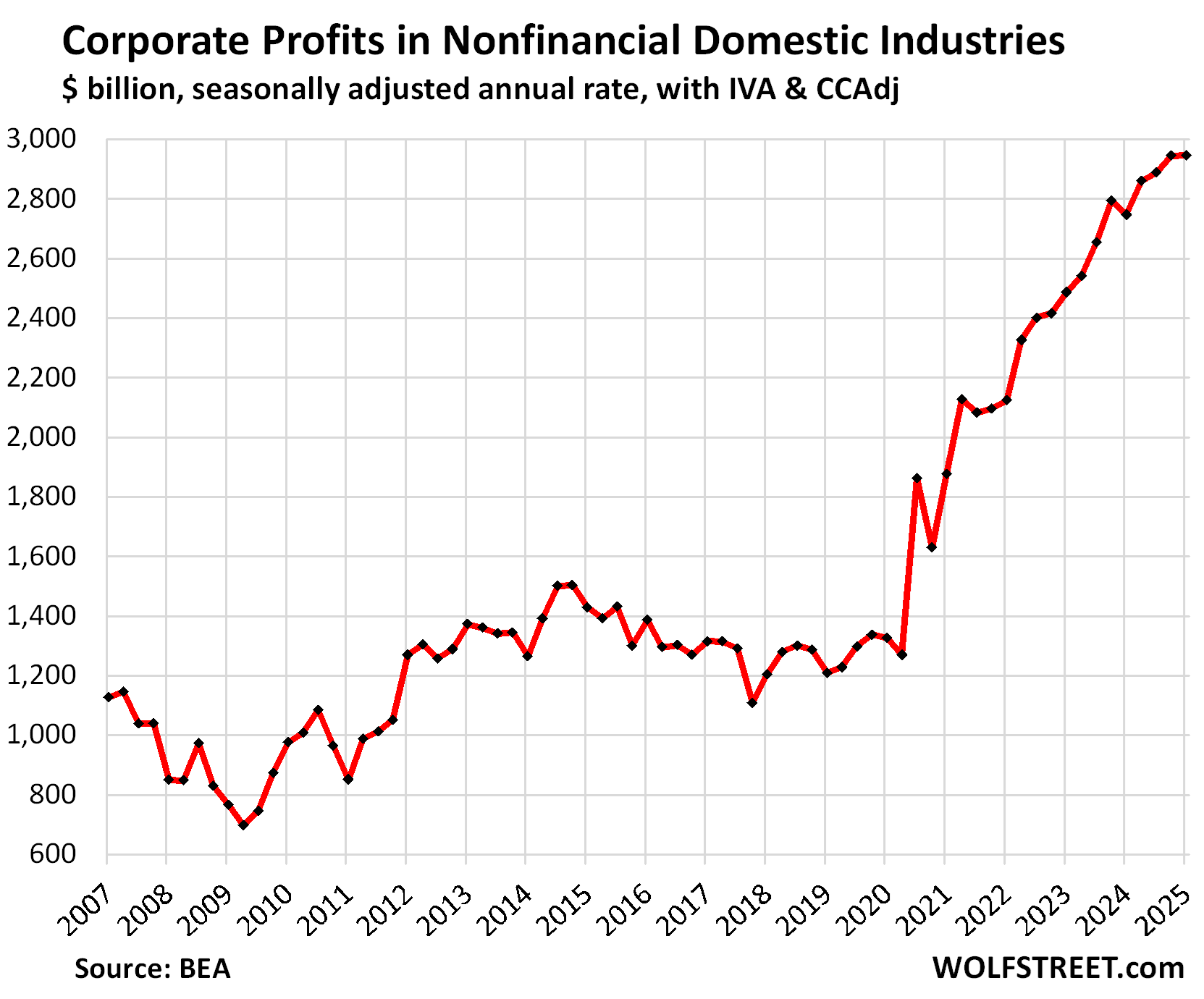
Enjoy reading WOLF STREET and want to support it? You can donate. I appreciate it immensely. Click on the mug to find out how:
![]()


Good article. Perhaps this will send the message why tariffs aren’t going to be passed to consumers the way the media points out. Corporate profits more than doubled in 5 years.
Time will tell! Most companies are just coming to understand what their long term tariff obligations are. It’s hard to pass anything on when the goal post are moving. Once the variable is know than people can make a logical decision. No longer guessing what their input cost will be.
the supreme court might rule against the trump tariffs strange things happen sometimes
True. People may wait longer to pass on increase if they think the increase may be declared illegal and void.
Good point!
“the supreme court might rule against the trump tariffs strange things happen sometimes”
I don’t think they will. For all the kabuki theater we get from our “two parties” the dems didn’t undo the tariffs after 2020 or the tax cuts. My theory: 2020 was a financial crisis, tariffs are being employed to offset the decline in certain groups buying our treasuries. Time will tell.
We didn’t get inflation in 08, some, but nothing like after 2020. Why is that? They did print more in 2020, but i think something else was the underlying cause. Perhaps that is why we are trying to start wars with Russia and China?
5 foreign holders of $Treasuries at May 2025 were: –
Japan $1134bn
UK $808bn
China $757bn
All Caribbean $674bn
Cayman Islands $448b
Who knew the UK was so wealthy? ;)
Mr. House
The City of London is a huge global financial center, and these Treasuries are held in custody for others, including US entities. Belgium, Ireland, etc. are similar. Ireland is a special place for Corporate America. All here, including the top seven financial centers:
https://wolfstreet.com/2025/07/18/the-foreign-investors-who-bought-the-recklessly-ballooning-us-debt-july-2025-update/
Be thankful that you live in USA. UK has bought your treasuries because nobody trusts the socialists running the Labour Party with anything vaguely financial. A slowing economy, zero growth, increased taxes and borrowings being the only certainty. UK pension funds are likely to be the biggest treasuries buyers. The country’s debt ratios are higher than the USA and trade deficits not far off. I happen to live in the Deputy financial minster’s political ward and I would hesitate to buy a box of matches from him. My daughter+family moved from Germany to the USA last year, now gets a far higher salary, much bigger house, more disposable income and living with people who appreciate wealth and know how to work to achieve it.
@Mr. House: Who’s this “we” that you claim are “trying to start wars with Russia and China”? As a first-person plural, that’s you and who exactly? By definition, those who start shooting are the ones who start a war. Being an apologist for them doesn’t wash.
I’m amazed at the crystal ball that so many people seem to have. Will companies pass on tariffs costs? Who knows? It’s a pretty safe bet, they will increase prices if they can.
The fact that many companies were able to raise prices during the COVID era doesn’t mean they want to give up those gains. It doesn’t mean they SHOULD give up those gains either. Funny how capitalists turn into anti capitalists when it suits their narrative.
Industries suddenly protected by tariffs walls may have a opportunity to raise prices. Supply demand imbalances may create an opportunity to raise prices. Yes only time will tell. The only thing I am sure about is companies will not be in a hurry to lower profits.
My broadband service went up by 60% last month. That’s where inflation is: in services. I have two other options: a fiber-to-the-home company which is even higher and cellphone. But I need a backup, and that’s the cellphone. So really, there are only two suppliers of broadband services for me, and they both know what the other charges, and it’s these duopolies in services that create inflation. Look at the first chart: services is where inflation is. And that’s where 70% of consumer spending goes, is into services. Tariffed goods are just a small part of what people spend their money on — and there’s usually quite a bit of competition online, which is why it’s hard to raise prices with goods. So get real.
1. Is there data that could help us understand if the services price increases are caused by tariffs raising the cost of goods used by service providers?
2. The surge in durable good inflation seems to suggest tariff passthrough.
1. Services prices have been soaring for years, long before tariffs, and they’re rising less now than they did before the tariffs, but they continue to rise. Inflation is always mostly in services because people cannot shop them easily and because there is little competition and because that’s where about 70% of consumer spending goes. Quit blaming new tariffs for past price increases in services.
2. Durable goods inflation was 0.9% year-over-year. Services inflation was 3.4%. First chart. That’s where inflation is, is in services. About 18 months ago, durable goods prices started turning around from the steep drop and that has continued. I spent all year last year and the first half of this year writing about it. I started saying in 2023 that durable goods prices cannot drop forever, that they will turn around, and that they will stop pushing down inflation. And they did exactly that.
Curious about your broadband choices. Why so limited in choices? Are resellers not permitted where you live? My broadband is Canada is now cheaper now than it was 10 years ago. The best deals are from service providers that are allowed to ride over the wires owned by the cable and phone providers physical networks. Of course I refuse the upselling offers. Most people don’t need a fraction of the speed that the service providers push on us.
The coax cable to the home is owned by Comcast, and no one else is allowed to use it. The fiber is owned by Sonic, and no one else is allowed to use it. Verizon has a 5G antenna across the street, and no one else can use it. AT&T provides our 4G and no one else is allowed to use it.
Car companies are in trouble. Higher new car prices?
Ford reported they would have reported a profit except for the tarrifs paid. So they reports a loss.
Procter and Gamble raising prices 5%
Just the beginning
It’s P&G’s customers that decide whether it gets away with these price increases or not. P&G has lots of competition. People buy this stuff online from anyone. P&G raised prices by 20%+ during the pandemic, and then had to cut prices because sales stalled. 5% is just a regular effort to jack up its revenues, nothing special about that.
Company announcements are just propaganda. Look at their quarterly financials and listen to their earnings calls and earnings warnings when they talk about actually did. You cited Ford, that’s what they actually did, they ate the tariffs. GM did too. They all did, is what they actually did, despite the propaganda some time ago was that they would raise prices, but that didn’t work because their customers didn’t go for those higher prices, and they had to offer deals to make the sales.
a lot more competition in the car industry than FMCG (once you get to the companies that own all the brands, ie P&G and Unilever).
Welcome to the dystopian world of the oligopoly. Here in Australia competition policy is dead (and has been for decades) so we get reamed by a small number of very large players in every industry !
They don’t own “all the brands.” They own the big brands that are highly advertised. There are lots of competitors beyond that.
Would love to see that corporate profits chart excluding the hyperscalars and saas. That’s not the inflation we’re looking for but it’s a huge portion of the corporate profit increase and continues to be (see this quarters earnings).
Question Wolf:
What are the odds the next move for rates is actually higher, not lower? Powell said something to the effect of “You could say we’re being accommodative not raising rates right now…” though the remark was very off-hand. I do think this is a small, real possibility that the market is not prepared for.
Also – what will determine if inflation is a one-off? It feels like an economic slowdown would force prices to stabilize, but this isn’t a great outcome. If onshoring takes time, and assuming companies continue to be either greedy or pinched, wouldn’t it make sense to just continue raising prices? Projected tariff costs generally were higher back half of the year vs current quarter and pre-tariff stockpiles should be depleted soon, so should least expect increasing prices through end of year (right?).
A called around to another car dealership after getting what looked like high routine maintenance costs. The nearest dealership offered to do the work about $200 less. I asked current dealer to match and they offered $200 in savings to stay, I stayed. $850 to $644. (transmission fluid fill / drain, break fluid flush, and differential fluid flush) Honda Pilot. Philadelphia. The four quarts of transmission fluid are about $35 / each retail. yes, we are shopping around for savings, $200 is significant for average homes.
👍 Kudos.
That kind of consumer behavior is the only thing that can keep inflation down. If consumers are willing to pay whatever, inflation explodes.
Inflation is the increase in the supply of money and credit, beyond the growth of productive output in the economy. No amount of savvy bargain hunting will change the definition of inflation or will have any affect on consumer price levels while the Fed continues to monetize the annual federal deficits.
What is this BS? The Fed hasn’t monetized any deficit in 3 years now.
Great Outdoors
Yours is a definition of monetary inflation.
It has nothing to do with “consumer price inflation,” which was proven beyond a reasonable doubt between 2009 and 2019, when there was lots of monetary inflation and very little consumer price inflation. Blew your theory out of the water.
And your theory is getting blown out of the water again: the Fed has been doing QT for three years, and look at the consumer price inflation we’re having!
The Federal Reserve is not in the slightest way monetizing any of the $37+ trillion federal debt. Do you know what monetizing debt by a central bank even means?
No matter how people want to count it if prices are going up we have inflation. And prices are going up right now not going down. We have inflation now and it’s increasing. And I’m afraid it’s just started, meat prices are skyrocketing, energy is going up. And if we are lucky enough to sell our meat and energy to other countries we’re in real trouble.
The US is a HUGE energy exporter: natural gas via pipeline and LNG (largest LNG exporter in the world), gasoline, diesel, jet fuel, crude oil, petroleum coke, propane, ethane, butane, even electricity to Canada. So don’t worry, energy prices in the US are driven by market conditions, and now the soaring demand for power by data centers, and not tariffs.
https://wolfstreet.com/2025/03/04/u-s-production-exports-of-crude-oil-petroleum-products-hit-new-record-in-2024-imports-dipped-further-spr-refilling-halted-in-february/
The US is a huge beef producer. It also exports beef. And it imports beef — neither of them huge.
The US produced 13.5 million tons of beef in 2024. It exported 1.5 million tons of beef in 2024, or about 11% of its production. The US imported 2.3 million tons of beef in 2024. So the US had a trade deficit of beef of only 800,000 tons, or less than 6% of its production.
So tariffs aren’t going to drive up beef prices. What HAS driven up beef prices for TWO YEARS are issues with the US herd.
@SoCal,
The Fed purchased and still owns Trillions in Treasury bonds, this is the definition of monetizing the Federal deficit, even as QT is very tentatively moving forward the last two years.
I agree with you Wolf that as long as people keep paying whatever, prices with increase to whatever the companies can get away with, including housing. I tell friends who complain, if you think the price of an item is too high, then don’t buy it. Don’t be stupid!
Labor rates are now $200 to $300 per hour and there is nothing unusual or extraordinary about those maintenance amounts.
$300/hour for simple fluid changes? Really?
Jake,great move on saving some bucks.
Your situation interested me,might I suggest you try the home pilots forum,a lot of good info there on the little guys and seems some very tech savvy folks there,almost went way down the rabbit hole as a shade tree mechanic but caught meself as,well…..,don’t own a Pilot!
Very interesting thoughts on the 6 speed there,best of luck with your vehicle!
The last graph that shows corporate profits tells the story right there. I don’t think there’s a question where inflation is really coming from.
Watch out for shops marking up the cost of parts/fluids. Honda ATF should not cost you $35/qt.
For DW1 you shouldn’t be paying more than $10-$12/qt and for ATF 3.1, probably $20-$25/qt – and this is for Honda OEM fluids right from the dealership. I regularly buy these fluids by the case (damn shame Honda doesn’t sell 5 qt jugs of the stuff retail, just single qt bottles).
Also, if you only paid for four quarts, the shop only did a 1x trans drain and fill. Depending on your interval you should be doing a 2x or 3x drain and fill. You don’t get all the fluid out of the torque converter the first time around.
Sorry to be a debbie downer but I’d suggest finding a better shop.
How do you know they actually did any of the work?
Serious question. I’ve had two buddies tell me (both Asian guys…just adding that because I find it amusing for some reason) how they marked tires before a tire rotation, and found the rotation never happened. Sleazy car dealers, man…(not Wolf, of course).
How much of that increase in profits in the last 5 years is from big tech and how much is from the rest of the other companies?
All you have to do is click on the link I provided in the article and read it. So here is the link again, with charts by industry:
https://wolfstreet.com/2025/06/26/the-corporate-profit-explosion-stalls-in-q1-on-the-eve-of-the-new-tariffs/
Just saw this, ignore my other comment!
While complaining bitterly about the Federal Reserve bringing its three 90 year old buildings up to modern code standards, Trump unveils plans to build breathtaking golden ballroom at White House
President Donald Trump is finally getting his White House ballroom. White House press secretary Karoline Leavitt announced on Thursday that construction would begin in September on a 90,000 square foot addition to the East Wing that would include Trump’s long sought-after ballroom.
White House ball room funded by donations
Trump wants to tear down and demolish part of the East Wing and the proposed new construction will result in huge annual maintenance costs borne by the government for essentially useless wasted space which will not be funded by ‘private donations.’
If Nixon put a bowling alley in the White House, I don’t see why they can’t have a ballroom there as well.
Because a ‘ballroom’ is a huge amount of totally wasted space and involves destroying a large existing part of the East Wing.
Horrible logic. Because someone else did something stupid that should excuse future idiotic ideas? Also Nixon didn’t end his tenure with exactly a great record in the WH, I don’t think that’s someone you want to point to as an example.
🤣 so true
Mark Zuckerberg just got another $28 billion. It could have been $128 billion if Jay cut
Jay can’t cut anything at all in interest rates at the Federal Reserve as that sort of thing is done by the 12 member FOMC of which 10 voted to keep them the same in July and only 2 voted to cut the overnight rates.
Of the 12 members of the FOMC, only 7 (seven) have any sort of “Western Democracy” nominating process. The other 5 (five) were selected by voting banks from only 1 (one) candidate at each Federal Reserve bank. Who knows what institutional factors are influencing those 5 (five) FOMC members in their interest rate decisions; it isn’t a US Senate verified allegiance to the Congressional stable money and jobs mandate.
I share that corporate profits charts every time someone says that tariffs will be passed on to the consumer. New cars are getting heavy discounts. Used cars we are holding firm. Hourly shop rate went up to over $300 per hour. It’s just not the customers that are paying that either. So does the sales department!
That hourly rate is incredible. A few years ago as a Professional Engineer with my own company, I couldn’t charge that much to major oil companies for consulting work. No wonder my friend’s last Audi oil change cost almost put him in shock.
Correct me if I’m wrong but doesn’t a percentage of corporate profits go to stock holders? Do we have that figure because that’s money in someone’s pocket that goes back into the economy(potentially)
You’re wrong. What actually gets paid to each stockholder are the dividends, if the company pays dividends. There is no requirement that a company pays dividends. These are profits of all companies of all sizes, many of them privately held, but include also all the big ones, and most of them don’t pay dividends.
Anthony A.
The hourly rate is not what the techs get paid. The techs gets a portion of it, the rest is gross profit for the dealer.
I understand that, but $300/hr for a service rate at a car dealership seems over the top. I can’t fathom an oil change costing $400 (one hour shop rate and 5 quarts of oil + filter). My rate in consulting was $200 – $250/hr and that had to cover my S Corp business expenses (out of f=date now, I know).
Could be that I am out of touch with dealer type auto repair rates since I have done my own auto repairs and maintenance over 50 years. Now I have a Bolt and just drive the thing except for tires and minor repairs that are not covered by the warranty.
Given the high rates of dealership shop time, no wonder the TV commercials are full of third party insurance companies hawking “repair insurance coverage”.
@Anthony A. The insurance companies are also hawking “pet insurance coverage” and “home repair coverage” hoping that they can follow the “health insurance” and “car accident insurance” where they make everyone pay for insurance and they really jack up the rates.
Shop rates were $175/hr pre pandemic. It’s certainly $250-$300 now after the big inflation.
(I got pre-paid maintenance when I bought car in 2019, great deal with inflation but now it’s run out).
@Anthony A
Find a quality independent mechanic. Mine charges half what the dealer does and doesn’t lie about what needs to be fixed.
$300/hr for work done by a kid who thinks he’s a mechanic because lowered his Civic and “knows how to do brakes” after his first pad-slap…
That the quality of labor is going down makes services inflation even worse.
Constantly amazed at food prices when I look around at things I don’t usually buy.
September rate cut off the table unless we have a surprise tomorrow 😳
What’s really interesting is to take 10 consumers.
See what each pays for the same item across multiple stores.
1 out of the 10 is a massive FIRE kinda person who lives to get a deal. That person pays wayyyy less than the other 9 people, but their hair turns grey. lol
I still do not really understand the people who pay a $700 fee to credit card companies for the super premium travel card, then jump thru 80 hoops to actually “earn” more than they paid.
Would you even buy that crap if you didn’t have to?
Agreed it’s crazy how people just but whatever and have no price sensitivity. You can do so much more in life if you just try and spread your dollars further!
Got the surprise in NFP this morning but not weak enough for a rate cut yet! Not with this inflation still well above target. Tough spot for the Fed. Tough spot for risk but the delusions can continue we will see
In terms of the NFP, that was VERY interesting data: The Crackdown on illegal immigration is slowing the supply of labor, which is shrinking, and demand for labor is slowing, but still growing, and as a result, a historically low unemployment rate and mucho upward pressure on wages:
Hot off the press:
https://wolfstreet.com/2025/08/01/slowing-supply-of-immigrant-labor-slowing-job-growth-keep-the-job-market-in-balance-and-the-unemployment-rate-low-push-up-wages-powell-talked-about-it/
The Fed’s dual mandate is “stable prices and maximum employment, not so much growth” in employment, Powell said at the press conference.
I learned the hard way: plant you own garden, and save, fix your own car, and save. Just knowing how to do these things gives you an edge Doing them saved a lot of money and, in old age, makes you feel like somebody besting the odds. Wow, I saved 600 US dollars today by changing the oils in my car!!!
“The core PCE price index, which excludes food and energy items, accelerated to +0.26% (+3.1% annualized).” -Wolf
3.1% seems quite a bit higher than the Fed’s target of 2.0%. Furthermore, it has been heading higher for the last four months. I thank Wolf for the two decimal places. With a robust employment picture, and at least some expected increase in core PCE because of tariffs (nobody knows how much) in addition to the increases we have seen in the last four months, the Fed should consider raising, not lowering the Fed Funds Rate. I am somewhat surprised the 20 and 30 year Treasuries are still somewhat below 5%.
Anyone remember when the Feds target was 0%?
I do
Their legal target still is 0%, they’re just ignoring their own legal mandate. Sorta like Wolf said about companies raising prices, the Fed can get away with it whenever people are willing to pay whatever.
The Fed (and most other country banks) choose a 2% target so that normal fluctuations around that target don’t risk it going below zero. Negative inflation is deflation and that is dangerous, hence the overly cautious 2% margin on the target.
”Negative inflation is deflation and that is dangerous, hence the overly cautious 2% margin on the target.”
Dangerous ONLY to the profligate and the so called financial industry B.
For workers/earners who are savers and thrifty who put their money to work carefully and with total liquidity or close to no risk as in Treasury Bills, Notes, and Bonds, so called negative inflation is a good thing…
The PROPAGANDA of the oligarchy who control the world’s finances is the only reason to fear ”negative inflation.”
There is value in a 2% vs 0% target. You can give your employees a small pay raise every year and it won’t effect your gross profits. They think they’re valuable to you because they get a 2% increase which reduces your turnover costs.
Anyone remember when the Feds target was 0%?
I do
Yep, let’s lower taxes for corporations with record profits. Makes perfect sense. Corps realized that they made more money during shortages by jacking prices. And did not lower them following Covid. Then the service types caught on. An HVAC mechanic now wants $280 to replace a $20 capacitor. The fix has now been in for years.
Good luck to recent retirees on their cost of living.
You can charge whatever the market will accept.
It’s the customers that are the dumb ones.
This goes for regular consumers and business consumers.
You can change your own capacitor for $20. I’ve done it on my AC and water heater. Simple.
Remember a capacitor has a stored charge and must be expended before being removed.
LOL.
I was trying to avoid some summer landscaping. I asked a guy that was working in the neighborhood for a quote to do a quickie clean up on my front and back yard. Its not that big. He quoted $500! I laughed and had in done in two hours myself and was able to get everything in one barrel.
I should start a landscaping business. Easy $1000 a day!
Even if I try to only purchase the necessities on the product end, the services end; of which I have little control over is going to stop the products. I just received my home insurance renewal for the year, up 38%. Property taxes go up 11% every year, every year!
What state do you live in?
MN
MN sucks – don’t get me wrong, beautiful state, but it’s just a screw to live there anymore. Cost of living went through the roof in the last 15 years.
@remy I just got a letter from Liberty Utilities the power provider at our Tahoe Area cabin that rates are going up 16% next year. If rates keep going up old people on fixed incomes are going to have to steal wood pallets from behind the grocery stores to cut up and burn to keep warm (like I did in college)…
Yes, inflation in services is pernicious and hard to stop.
“What Powell is waiting for…” Answer: he is waiting for his term as Chairman to run out in May 2026. This is apparent as well from those two lower interest rate “brown nosers” that media is reporting as seeking President Trump’s nomination to replace Powell.
I do work on me own vehicles and friends and on average have seen parts go up slightly.
I do buy a lot on the net and save meself and others a few bucks that way.
I had no idea how much dealerships were charging a hour!
I also have never seen retail 45 a quart for transmission fluid but then am working on older stuff for most part……,damn,glad I can still turn a wrench!
I do nearly all my own services – and very well – including mechanic. I actually hate working on cars, but knowing it gets done and correctly (RE, my comment above) and not paying more than my own hourly labor cost to have to worry someone is screwing me is worth the trouble.
I hate it – and it scares the hell out of me – that I can’t be my own doctor.
“We wiped out inflation” said T – Rump last Friday. This comment is totally divorced from reality. And today it was announced that he is going to have the White House ball room renovated at a cost of $200 Million.
The way our country is going, they should have a congressional bake sale for any dances, and have the dances at the local YMCA, or community center. $200 Million for a ballroom is complete insanity.
IMO, there will be a parade of companies raising prices.
First reaction to tariffs, business wise, is to eat them. That is easiest.
But the financial realities will kick in. Each company that raises prices will make it easier for others to justify such.
As for market conditions allowing price increases, IMO people are expecting inflation and that will break trail for the price increases. Ever higher stock prices plant the “mood” of higher prices across the economy, IMO.
Inflation…
“It’s a feature, not a bug!”
It’s a money-hoarding tax. USD are a little bit perishable.
Yen is up almost 2% today! Mic drop!!!